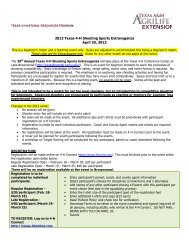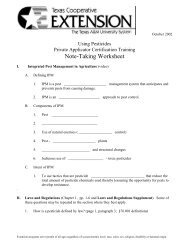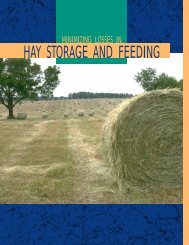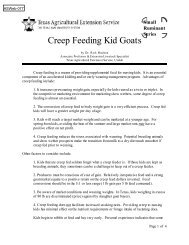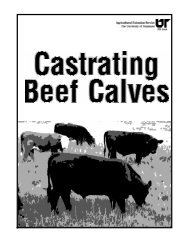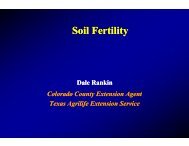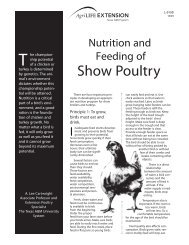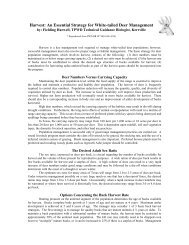Animals Title: Dairy-licious! Author(s) - Texas 4-H and Youth ...
Animals Title: Dairy-licious! Author(s) - Texas 4-H and Youth ...
Animals Title: Dairy-licious! Author(s) - Texas 4-H and Youth ...
- No tags were found...
You also want an ePaper? Increase the reach of your titles
YUMPU automatically turns print PDFs into web optimized ePapers that Google loves.
THE SCIENCE OF AGRICULTURESection:<strong>Animals</strong><strong>Title</strong>:<strong>Dairy</strong>-<strong>licious</strong>!<strong>Author</strong>(s): Cheryl NewberryTime:30 minutesObjectives:Students will learn: facts about dairy cattle. what products are made from milk. to identify foods in their diet that contain milk.TEKS: Science Health EducationSupplies/Materials/H<strong>and</strong>outs Needed: <strong>Dairy</strong> Cattle Breeds Food Label Investigation: Milk HuntPreparation for Lesson:Lesson Content:What is the difference between dairy cattle <strong>and</strong> beef cattle?<strong>Dairy</strong> cattle are bred to produce milk. They are shaped like a trapezoid <strong>and</strong> have much less muscle onthem than beef cattle. They look very boney <strong>and</strong> some would say unhealthy, but that is how they aresupposed to be.Beef cattle are bred to produce meat or beef. They are shaped like a rectangle <strong>and</strong> are muscular.Can anyone guess how much milk a dairy cow will produce each day?The average cow produces about 19,825 pounds of milk each year. That's 2,305 gallons of milk a year orabout 8 gallons of milk every day of her milking period. That’s enough for 128 peopleto have a glass of milk every day!There are a few common breeds of dairy cattle. Does anyone know what the most common dairy cattlebreeds are?The Holstein is the most common milk producing cow. Other breeds include Guernseys, Jerseys, BrownSwiss, Ayrshires, <strong>and</strong> Milking Shorthorns. Let’s take a look at these six breeds.Distribute copy of h<strong>and</strong>out, <strong>Dairy</strong> Cattle Breeds.Each of these breeds looks a little different. Some are spotted, some are solid. They can be differentcolors as well! Can you see the trapezoid shape of these dairy cows <strong>and</strong> how their bones stick out on theirhips?Educational programs of the <strong>Texas</strong> AgriLife Extension Service are open to all people without regard to race, color, sex, disability, religion, age, or national origin.The <strong>Texas</strong> A&M University System, U.S. Department of Agriculture, <strong>and</strong> the County Commissioners Courts of <strong>Texas</strong> Cooperating
Cows are BIG eaters. A cow spends a lot of time eating. Can you guess how many hours a day a coweats?Cows eat up to 8 hours per day. Cows eat 90 pounds of food a day! A cow that chows on only grass canmake 50 glasses of milk a day. But one that eats grass, corn <strong>and</strong> hay can make 100 glasses of milk a day!Cow's teeth are different from ours. On the top front, cows have a tough pad of skin instead of teeth. Theyhave 8 incisors on the bottom front <strong>and</strong> 6 strong molars on the top <strong>and</strong> bottom of each side to grind theirfood. Cows have a total of 32 teeth.How much water do cows drink each day?Cows drink 25-50 gallons of water each day. That's nearly a bathtub full. That is a lot more than wedrink, isn’t it?Milk is an important part of our diet. Does anyone know how much milk we should include in your dieteach day?We need 3 cups of milk each day. If you like milk, it is probably easy to get enough milk or milk productservings in your diet. If you don’t like milk, then you’ll have to eat other products that have milk in themto get enough in your diet!How do we get three cups of milk in our diet each day besides just drinking milk?We can get milk in our diet by eating other foods that have milk in them or that are made from milk.What products are made from milk?Products made from milk include: Butter Cream Cottage Cheese Cheese Cream Cheese Yogurt Ice Cream Dried Milk ButtermilkWhat are foods that we eat that have milk or milk products in them?Some examples include: Most breads, cakes, cookies, muffins have milk or buttermilk <strong>and</strong> butter in them Foods with a white sauce like chicken enchiladas, fettuccini Alfredo, cream of chicken or creamof mushroom soup, usually have milk in them Dips with cheese, cream cheese, or yogurtWhat nutrients does milk contain that makes it healthy for us?Page 2 of 7
Milk contains vitamin D <strong>and</strong> Calcium. It also contains fat which can give us energy. Some milk has hadsome of the fat removed to make it lower in fat, but it is still good for us. You may have seen in thegrocery store the different types of milk: Whole Milk, 2%, 1%, or Skim.Where does chocolate <strong>and</strong> strawberry milk come from?These flavors of milk are made by adding chocolate or strawberry flavoring to milk. Chocolate milkdoes not come from a brown cow <strong>and</strong> strawberry milk does not come from a red cow!Do you think you are getting enough milk in your diet every day? If not, I hope you will try to increasethe amount of milk you drink or eat other things like cheese, yogurt, <strong>and</strong> cottage cheese to make sure youbuild your bones with all that calcium!Activity: <strong>Dairy</strong> Investigation: Milk HuntDistribute a copy to each child of the h<strong>and</strong>out, Food Label Investigation: Milk HuntToday, we are going to do some investigating of a menu to see what food items have milk or milkproducts in them. Read the menu <strong>and</strong> see if you can identify the foods that have milk or a milk product inthem <strong>and</strong> mark one of the columns, “Got Milk!” Or “No!”Review the h<strong>and</strong>out with the children after they have had time to complete the worksheet. The answer keyis provided.Conclusion: What is your favorite dairy or milk product? How many different breeds of dairy cows did we talk about today? Holsteins, Guernseys,Jerseys, Brown Swiss, Ayrshires, <strong>and</strong> Milking Shorthorns What do cows use to make milk? Grass, hay, corn <strong>and</strong> lots of water How much milk can a cow produce each day? 8 gallons What foods do you plan to add to your diet to make sure you get enough dairy to equal 3 cups aday?Page 3 of 7
<strong>Dairy</strong> Cattle BreedsWhat kinds of cattle produce milk? Check them out below!Holstein Guernsey JerseyMilking Shorthorn Ayrshire Brown SwissCircle the words below inthe word search!BREEDSCALCIUMGRASSHOLSTEINHOOFJERSEYTEETHTRAPEZOIDUDDERVITAMIN DY M Z O C A L C I U M U H WH K F K M O F C Y O J B C XD E I F X O A E T T K D H TR Z O F Y Y I E O X Z I O FI O J A L E M L C B Z O L NH I M F X F S J C N A Z S FV I I S D E E R B X X E T TI T L J S G U Z E A I P E ET W E G Y E Q S X J T A I QA Y T E D N S X R J R R N DN M J U T A W U N P E T Y GI S X M R H R O K I K A U BN X Y G X H M W R E D D U KD O O V M O H T M N E M Q BPage 4 of 7
<strong>Dairy</strong> Investigation: Milk HuntInstructions: Read the meal menus below <strong>and</strong> identify which foods have milk or milk products in themby marking in the correct column (Got Milk! Or No!)Menu Got Milk! No!Breakfast1 Ham & Cheese Omelet1 piece toast1 4 oz. Container Strawberry Yogurt1 cup Orange JuiceLunch1 Cup Potato Soup5 crackers1 cup Cottage Cheese <strong>and</strong> PeachesLemonade1 Mozzarella Cheese StickAfternoon Snack1 Cup Strawberries with Yogurt DipDinner1 cup Chicken <strong>and</strong> Rice Casserole½ cup Green Beans½ cup Carrots1 Yeast RollIce TeaHot Fudge SundaePage 5 of 7
Question 4: Concept pour travailler les groupes de pression6 pointsS<strong>and</strong>ro Rezzonico veut se consacrer aux groupes de pression (stakeholders) de son entreprise.Certains aspects de base ne lui sont pas clairs, c’est pourquoi il s’adresse à vous: „J’ai lu dansun ouvrage spécialisé qu’il existe différents concepts de relations avec les groupes de pressiond’une entreprise. J’ai retenu les termes „concept stratégique de relations avec les groupes depression“ et „concept éthique (ou normatif critique) de relations avec les groupes de pression“.Quelles sont les différences entre ces deux concepts pour mon entreprise?“.Décrivez de manière générale et à l’aide d’un exemple concret concernant les groupes de pressionde BIO-PLUS, la différence entre ces deux concepts.Examen modulaire Management 1 «Bases de l’économie d’entreprise» ExamenEdition: Printemps 2010 Version 1.0.0 Dernière révision: 14.01.2010 Directeur d’examen Impression: 14.01.2010 Page 7/12



